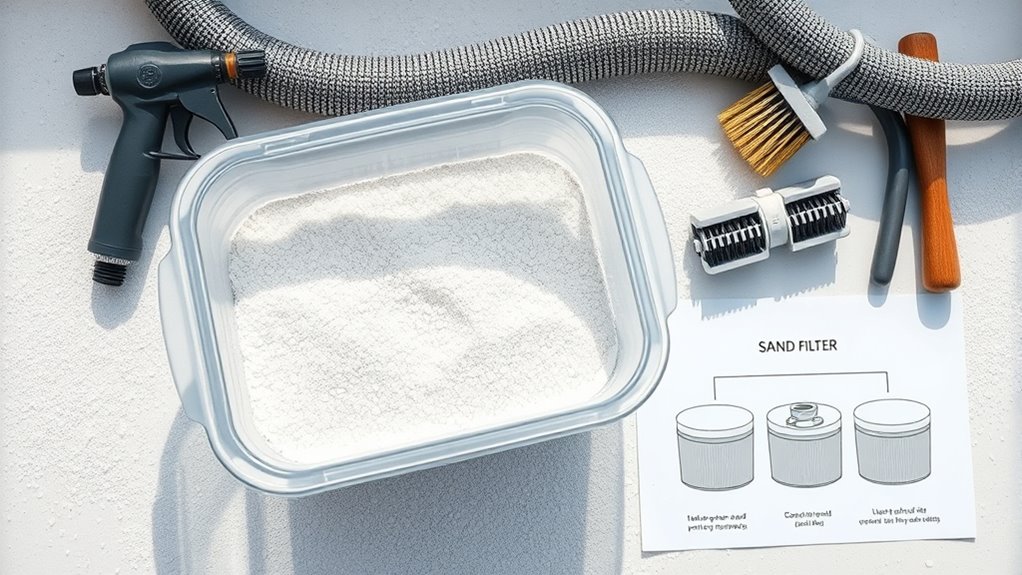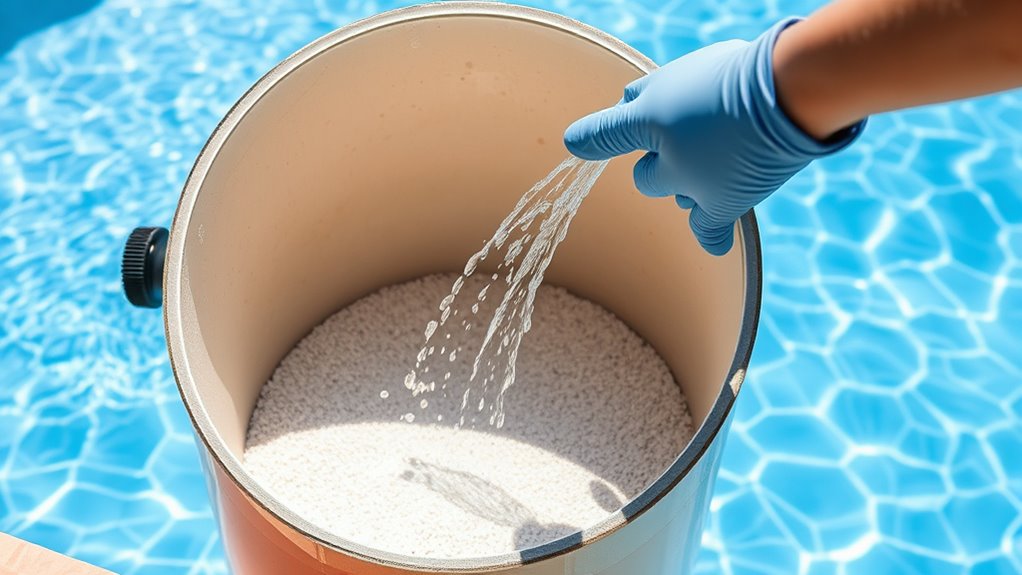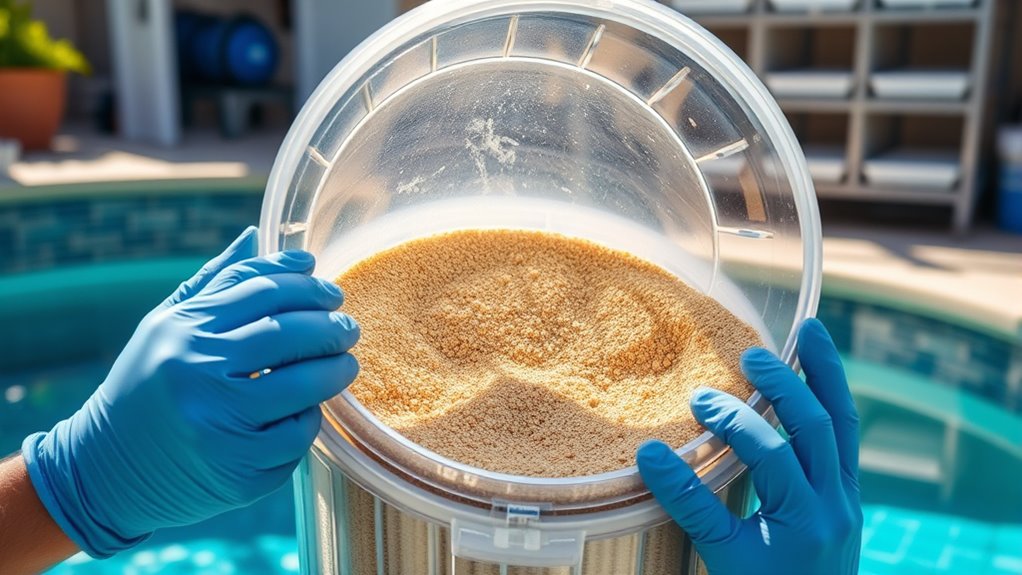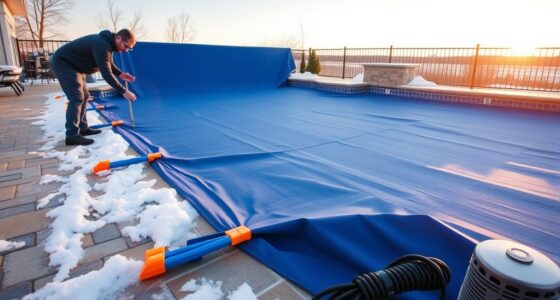To restore good flow in your sand filter, start by gathering supplies like a hose, cleaner, and replacement sand if needed. Turn off the pump, backwash the filter until water runs clear, then inspect and remove the sand bed. Rinse or replace the sand if necessary. Finally, restart the system and monitor pressure, flow, and leaks. Following these steps guarantees a thorough clean—keep going to learn how to optimize your filter’s performance even further.
Key Takeaways
- Shut down the pump, set the multiport valve to “Backwash,” and run until water runs clear to remove debris.
- Carefully remove the sand bed, inspect for clumping or debris, and rinse with a hose if needed.
- Rejuvenate the sand by removing the top layer or replace the entire bed if it shows persistent dirt or damage.
- Reassemble the filter, gradually restart the pump, and monitor flow rate, pressure, and leaks to ensure proper cleaning.
- Regularly inspect and maintain the sand filter to prevent clogging and restore optimal flow efficiency.
Gathering Your Supplies and Preparing for the Deep-Clean

Before starting your deep-clean, gather all the necessary supplies to guarantee the process goes smoothly. You’ll need a garden hose with a spray nozzle, a multi-purpose cleaner, a bucket, a screwdriver, and possibly a replacement sand. Wear gloves and safety goggles to protect yourself. Check your filter’s manual for specific tools or chemicals recommended by the manufacturer. Clear the area around the filter to give yourself ample space to work. Having everything ready beforehand prevents interruptions once you start. Make sure your water supply is turned off, and if you plan to replace the sand, purchase the appropriate type and amount in advance. Proper preparation ensures a smooth, efficient cleaning session and helps you avoid unnecessary trips or delays. Additionally, understanding the importance of filter maintenance can help you extend the lifespan and efficiency of your sand filter.
Shutting Down and Backwashing the Filter

Wondering how to properly shut down your sand filter before cleaning? First, turn off the pump to stop water flow. Next, set the multiport valve to the “Backwash” position to prepare for cleaning. Finally, restart the pump to begin backwashing. During this process, water flows in reverse, lifting debris from the sand bed and flushing it out. Keep an eye on the sight glass or waste line to see when the water runs clear, indicating cleaning is complete. Once backwashed, turn off the pump again and set the valve to “Rinse” for a brief rinse cycle. This step guarantees any remaining debris is flushed out, preparing your filter for a deep clean and peak performance. Proper backwashing is essential for maintaining the safety and efficiency of your filter system.
Removing and Inspecting the Sand Bed

After completing the backwash and rinse cycles, turn off the pump and set the valve to the “Backwash” position again. Carefully disconnect the multiport valve and remove the filter tank lid. With caution, lift out the sand bed, supporting it to prevent spillage. Inspect the sand for clumping, discoloration, or debris buildup, which indicate the need for cleaning or replacement. Check the laterals and distribution system for clogs or damage. If you notice any broken or clogged parts, replace them before refilling. Use a hose to rinse the sand if necessary, removing dirt or debris stuck in the bed. This step helps you identify issues that might hinder proper flow and guarantees your filter operates efficiently after cleaning. Regular maintenance and proper filter care are essential to extend the lifespan of your sand filter and ensure optimal performance.
Replacing or Rejuvenating the Sand

If your sand bed shows signs of persistent clumping, discoloration, or debris buildup despite rinsing, it’s time to replace or rejuvenate the sand. Over time, the sand loses its effectiveness at filtering and needs fresh material or a thorough cleaning. Rejuvenating involves removing the top layer of dirty sand and replacing it with clean sand. Replacing means draining the entire filter, removing all the old sand, and adding new. To help visualize, consider:
- You’re swapping worn-out, compacted sand for fresh, free-flowing grains.
- The filter’s flow improves as debris and dirt are removed from the sand bed.
- Your pool water becomes clearer, cleaner, and easier to maintain.
- Ensuring the correct contrast ratio in your filtration system can enhance the visibility of debris removal, leading to better pool clarity.
Choosing the right approach depends on the level of clogging and the age of your current sand.
Restarting and Monitoring Filter Performance

Once you’ve replaced or rejuvenated your sand, the next step is to restart your filter carefully and monitor its performance closely. Turn on the pump gradually to prevent stress on the system. Observe the flow rate and listen for unusual noises. Check for leaks around the filter and connections. Keep an eye on the pressure gauge; a rising gauge suggests clogs, while a drop indicates flow issues. Regularly inspect for debris or sand leaks. Maintain proper chemical balance in your pool to avoid clogging. Monitor water clarity over the next few hours. Use the table below to track key parameters:
| Parameter | Ideal Range |
|---|---|
| Flow Rate | Consistent, smooth flow |
| Pressure Gauge | Within recommended limits |
| Water Clarity | Clear and clean |
| Leak Inspection | No leaks detected |
| Sand Level | No significant loss |
Frequently Asked Questions
How Often Should I Deep-Clean My Sand Filter?
You should deep-clean your sand filter about once every 3 to 5 years, depending on usage and water quality. Regular backwashing helps maintain flow, but a thorough deep-clean removes accumulated debris and oils that can clog the sand. If your pool’s water becomes cloudy or flow decreases markedly, it’s a good sign you need to deep-clean sooner. Proper maintenance ensures your filter works efficiently and keeps your pool water clean.
What Signs Indicate My Sand Filter Needs a Deep Clean?
You’ll notice your sand filter needs a deep clean when the pool’s water becomes cloudy, algae starts to grow, or the flow rate slows markedly. If you’re constantly backwashing or seeing debris in the skimmer basket, it’s a clear sign. Additionally, if cleaning the filter doesn’t improve water clarity or flow, it’s time for a thorough deep-clean to restore proper filtration and keep your pool sparkling.
Can I Use Alternative Cleaning Agents for the Sand Bed?
Did you know that using harsh chemicals can harm your filter’s sand and reduce its effectiveness? You should avoid alternative cleaning agents like bleach or degreasers. Instead, opt for a gentle deep-cleaning process using a filter-cleaning solution specifically designed for pool filters. This preserves the sand’s effectiveness and extends its lifespan. Always follow the manufacturer’s instructions to guarantee safe and efficient cleaning.
How Do I Prevent Sand From Escaping During Backwashing?
To prevent sand from escaping during backwashing, guarantee your valve is set correctly to the backwash position before starting. Use a slow, steady flow rate to avoid disturbing the sand bed excessively. Check that the standpipe and laterals are secure and in good condition. If you notice sand escaping, stop the process and inspect for damage or misalignment. Proper setup and gradual flow adjustments keep your sand contained.
Is It Necessary to Replace Sand Every Year?
Think of your pool’s sand as a garden’s soil—over time, it becomes less fertile and less effective. You don’t need to replace it every year; instead, test and clean it regularly. If you notice cloudy water or decreased filtration, consider a deep clean or replacing the sand. Proper maintenance keeps your pool healthy, just like nurturing a garden guarantees vibrant growth without constantly replanting.
Conclusion
Think of deep-cleaning your sand filter like giving it a fresh start—it’s the breath of new life your pool needs. By gathering supplies, shutting down properly, inspecting, and rejuvenating the sand, you ensure your filter runs smoothly again. Keep a close eye on performance after restarting, and enjoy crystal-clear water. With these steps, your filter will work like a well-oiled machine, keeping your pool inviting and sparkling all season long.









